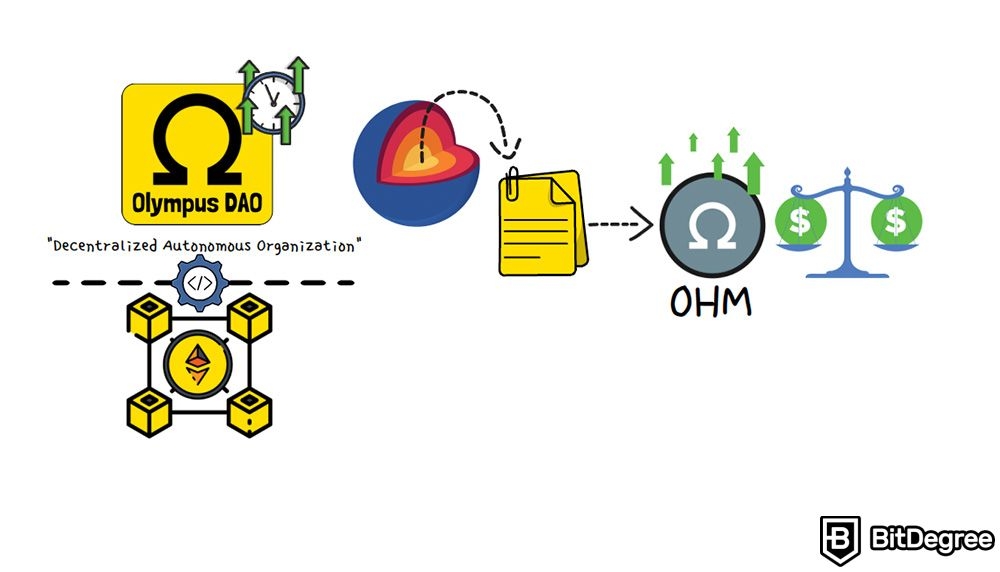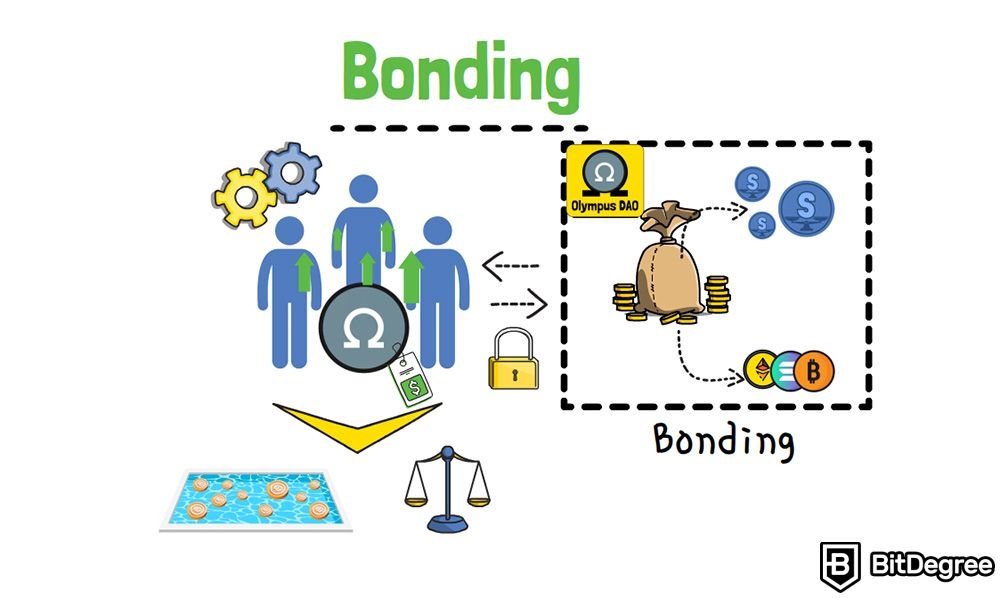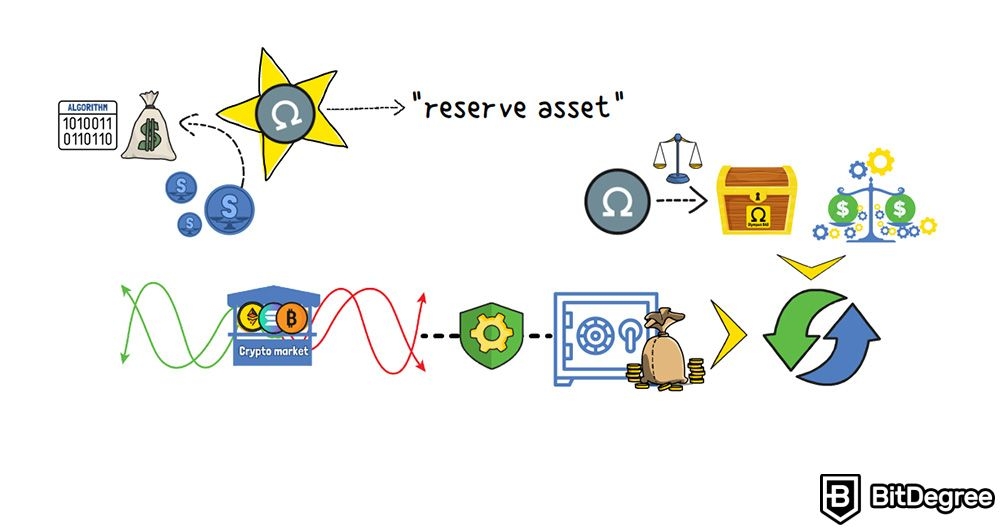2.17 Does Olympus DAO Have Anything to Do With Mythology?
Free Airdrop Season 7 is LIVE! Answer fun questions or do simple tasks to earn rewards from the $30K BitDegree prize pool. Participate Now ! 🔥
In this section, we’ll find out the answers to questions like “What is Olympus DAO?”, “What network is Olympus DAO on?” and “What is OHM crypto?”
If you’re new to the crypto scene, understanding Olympus DAO may seem similar to climbing the actual Mount Olympus! There are many attempts at explaining Olympus DAO in a simplified manner, but a lot of them may seem a bit too confusing for those who lack knowledge about the general DeFi landscape. But once you get past the first step, you begin to understand why Olympus DAO is commonly viewed as one of the most innovative and promising DeFi projects that there is.
When it comes to Olympus DAO, you get to face many challenging concepts. From reserve currency to stablecoins, from DeFi protocols to staking, Olympus DAO encompasses seemingly everything! Therefore, understanding Olympus DAO gives you a better view of the overall land of crypto, as well. Just as if you were observing it from the top of Mount Olympus!
In this section, I'll answer the big questions of “What is Olympus DAO?” and “What is OHM crypto?”, as well as take a look into fascinating ways of how does OHM work crypto. And, in the process of doing so, I’ll explain every term that could appear confusing!
It’s gonna be quite a ride, so brace yourselves, and let’s kick it off!

Video Explainer
Video Explainer: Does Olympus DAO Have Anything to Do With Mythology?
Reading is not your thing? Watch the "Does Olympus DAO Have Anything to Do With Mythology?" video explainer
What is Olympus DAO? (OHM Crypto Animated Explainer)


What is Olympus DAO?
Created in 2021, Olympus DAO is a relatively new project. It was conceived after a realization that the entire crypto market relies too heavily on fiat-backed stablecoins. This was a problem. Thus, one anonymous developer decided to attempt to solve it. It’s a quest of almost mythological proportions, but the developer understood the market’s need for it and had the confidence to attempt it. Also, they had a very appropriate pseudonym for doing so – Zeus.

But, as you can see, this is a rather high-tech project - we’ve just started, but I’ve already mentioned three concepts that require some extra attention. These concepts are DAO, fiat, and stablecoins. In order to fully understand what is Olympus DAO, we must make sure everything is clear.
First of all, a DAO, or Decentralized Autonomous Organization, represents a self-governing entity powered by blockchain technology, where decision-making processes and governance structures are decentralized and governed without a central authority. DAOs enable participants to collectively make decisions, manage resources, and shape the direction of the organization through a consensus-driven approach.
There's an entire section about DAOs, be sure to check it out!
Now, fiat refers to traditional currencies issued and regulated by governments, such as the US dollar or the Euro. In the context of crypto, fiat often serves as a benchmark or reference point for value comparison. It provides a means for users to evaluate the worth of cryptocurrencies, facilitating conversions, trading, and the establishment of value within the broader crypto ecosystem.
The notion of fiat remains relevant as a reference point and a bridge between the traditional financial system and the evolving world of digital assets.
And when it comes to a stablecoin, it’s a type of digital asset designed to maintain a stable value, typically pegged to a specific reserve asset like a fiat currency or a commodity. Unlike other cryptocurrencies, stablecoins aim to mitigate the volatility that often characterizes the crypto market.
Once again, there's a separate section about this topic, so if you feel unsure, check it out!

Having established a clear definition of these concepts, it’s easier to understand what I meant when I said that Olympus DAO was created to solve the problem of the cryptocurrency market being too reliant on fiat-backed stablecoins. Now, let's go deeper and actually answer the questions of “What is Olympus DAO crypto?” and “What is OHM crypto?”
So, Olympus DAO is an innovative Decentralized Autonomous Organization that operates on the Ethereum blockchain. At its core, OlympusDAO seeks to establish a protocol where a native cryptocurrency, known as OHM, can thrive and serve as a stable store of value.
Wait a minute. What’s a protocol?
A protocol refers to a set of rules and specifications that govern how different components within a blockchain ecosystem interact with each other. Just like a language that enables communication, a crypto protocol establishes the framework for the seamless functioning and coordination of various participants within a decentralized network.
So, when we’re talking about Olympus DAO, we’re talking about a creation of a whole new set of rules that would redefine the entire DeFi game when it comes to maintaining a stable value.
The fundamental concept behind Olympus DAO lies in the reimagining of reserve assets. Instead of relying on traditional fiat-backed or algorithmic approaches (like Terra LUNA did), OlympusDAO introduces a rather revolutionary mechanism called "The treasury model." This model employs a combination of bonding, rebasing, and liquidity provision to create a resilient ecosystem.
Okay… Once again… What do these terms mean?

Firstly, "bonding" refers to the process where participants lock their assets, such as stablecoins or cryptocurrencies, within the OlympusDAO protocol in exchange for OHM tokens, the protocol’s native tokens. By bonding their assets, participants contribute to the liquidity and stability of the ecosystem, supporting the value of OHM as a reserve asset.
Next, "rebase" represents a unique mechanism employed by OlympusDAO to automatically adjust the supply of OHM based on market price movements. Through this process, the supply of OHM expands or contracts, aiming to maintain stability around a target price known as the "reserve currency." This innovative approach mitigates volatility risks and ensures the stability of OHM as a store of value. By the way, if you feel confused, we’ll look deeper into this aspect in a moment!
Lastly, "liquidity provision" involves the act of supplying assets to decentralized exchanges or liquidity pools within the OlympusDAO ecosystem. By providing liquidity, participants enhance the efficiency and depth of the market, enabling smooth trading and the seamless exchange of assets within the protocol.
These three components - bonding, rebasing, and liquidity provision - work harmoniously to foster a resilient ecosystem within Olympus DAO. They empower participants to actively contribute to the stability, liquidity, and growth of the protocol, creating an environment where OHM can thrive as a sustainable reserve asset.

Well, I told you that understanding Olympus DAO is like climbing up the actual mountain! But don’t worry, eventually, once you get to the top of it and see the view over the DeFi world, that makes it all worth it! Okay, back to answering the question, “What is Olympus DAO crypto?”
At the heart of the Olympus DAO model lies the OHM token. OHM functions as both a reserve asset and a governance token, conferring voting rights to its holders, allowing them to actively shape the future direction of the protocol. Remember - that’s where the “DAO” in “Olympus DAO'' comes from! It’s a decentralized, democratic project!
And this community-driven governance isn’t just a “feature.” It’s one of the distinguishing aspects of the OlympusDAO project. OHM token holders have the power to shape the trajectory of the protocol, proposing and voting on various upgrades, enhancements, and policy changes. This decentralized governance framework ensures a collective decision-making process that aligns with the interests of the community.
So… I hope you’re not out of breath, because our hike to the top of the Olympus DAO mountain isn’t over yet!
What is OHM Crypto?
Okay, usually, I try not to talk about different concepts, such as Olympus DAO and OHM, at once. But in this case, while presenting the answer to the “What is Olympus DAO crypto?” question, I’ve already mentioned its native cryptocurrency OHM more than once. It’s because, otherwise, the answer to the question wouldn’t have sufficed! But OHM requires a bit more attention.
OHM, also referred to as the “Olympus DAO token” or “OHM Olympus coin” is the native token of Olympus DAO. It holds a unique position within the crypto industry, bringing forth innovative tokenomics and contributing to the evolution of the overall ecosystem.
The uniqueness of OHM lies in its role as a reserve asset. Unlike traditional stablecoins backed by fiat or algorithmic mechanisms, OHM derives its stability from the OlympusDAO treasury's reserves and a robust stability mechanism. This approach creates a self-sustaining ecosystem, where OHM acts as a stable store of value, resistant to external market fluctuations.

You see, when you realize what’s the entire point behind OHM’s creation, you start understanding why it’s called OHM. It sounds very similar to “Om,” which, according to ancient Hindu scriptures, is the sacred sound of the universe, a.k.a. the sound of everlastingness. Which, indeed, sounds pretty stable, and that’s what Olympus DAO is after!
In its unique approach, OHM has contributed to the improvement of the crypto industry by introducing novel concepts, such as treasury-based stability models and community-centric governance. By providing an alternative to traditional reserve assets and centralized decision-making structures, OHM showcases the potential for decentralized and sustainable financial systems.
Olympus Treasury
By now, we have established what makes Olympus DAO and OHM so ambitious and outstanding. But let’s take a closer look at how this reserve currency works. And, what is a reserve currency, after all?
So, first of all, let's demystify the concept.
In short, a reserve currency refers to a widely accepted and held currency by central banks and international institutions as a means to facilitate international transactions, store value, and maintain stability in the global financial system.
A reserve currency holds a special status, often being used as a benchmark for exchange rates and serving as a preferred medium for settling international debts. It plays a crucial role in facilitating trade, investment, and financial activities on a global scale.
The primary reserve currency historically has been the US dollar, but other currencies like the euro, yen, and pound sterling have also served as reserve currencies to varying degrees. The designation of a reserve currency is influenced by factors such as a country's economic strength, political stability, and the depth and liquidity of its financial markets.

In the context of cryptocurrencies, the emergence of reserve currencies like OHM within decentralized systems offers a new perspective. These reserve currencies aim to provide stability and a means for the store of value within the crypto ecosystem, creating a self-sustaining framework that operates independently of traditional fiat currencies.
And OHM does that, thanks to the Olympus Treasury.
The Olympus Treasury lies at the heart of OlympusDAO, serving as a vital component that underpins the stability and value of the OHM reserve currency. It is a pool of assets composed of more than $200M worth of crypto assets that are held within the protocol. This treasury forms the backbone of the ecosystem, providing the necessary reserves to support the stability and value of OHM.
But how does this OHM reserve currency actually work? Well, the OHM reserve currency is the target price at which the Olympus DAO protocol strives to maintain stability. It represents the ideal value for OHM, acting as a reliable store of value within the ecosystem.
To achieve this stability, the OlympusDAO protocol implements a unique mechanism. When the price of OHM rises above the target, new OHM tokens are minted and added to the treasury, expanding the supply. Conversely, when the price falls below the target, the previously mentioned process of "bonding" occurs, where participants can bond their assets to receive OHM, reducing the supply.
This creates a feedback loop between the treasury and the supply of OHM, enabling the protocol to automatically adjust and maintain stability. By expanding or contracting the supply in response to market conditions, the OlympusDAO ecosystem aims to keep the OHM reserve currency closely aligned with its target value, fostering confidence for participants.
Criticism
At this point, it may seem that Olympus DAO is, without a doubt, the winner’s choice. But, as it’s the case with all things in life, everything has two sides to it. And Olympus DAO is far from being immune to skepticism.
This project has been accused of being a Ponzi scheme, simply due to their staking system being perceived as unsustainable to the point of being unreliable, and, therefore, fraudulent. Such criticism stems from the conviction that high-yield investment programs are doomed to fail, and, therefore, people shouldn’t turn their guard off when it comes to trusting financial projects.
The room for doubt is created not only by the project’s innovative, therefore, yet-to-be-tested tokenomics, but by the fact that the idea of being pseudo-anonymous is practiced within the Olympus DAO management. Zeus, the creator of the whole thing, is an example. Critics would ask: “Why hide your identity, if everything’s so brilliant?”
The thing is simple. Olympus DAO truly stands out for their groundbreaking, never-seen-before solutions and thinking forwards. Yet, when it comes to crypto, sometimes things turn out to be less robust and failure-proof when something unexpected happens.
Wrapping Up
Finally, we have reached the mountain top! By now, the questions of “What is Olympus DAO?”, “What is OHM crypto?”, and even “What network is Olympus DAO on?” have been answered. I told you - understanding this concept can get a bit daunting. But if you don’t skip any key points, don’t ignore essential terminology, and stay attentive, the clouds evaporate, and things become much clearer.
And by now, it’s easy to summarize the fact that Olympus DAO has contributed to the broader DeFi landscape by offering an alternative store of value and stability within an ecosystem driven by community governance. This pioneering approach has garnered attention, sparked conversations, and paved the way for further exploration and innovation in the sphere of cryptocurrencies and decentralized systems.










